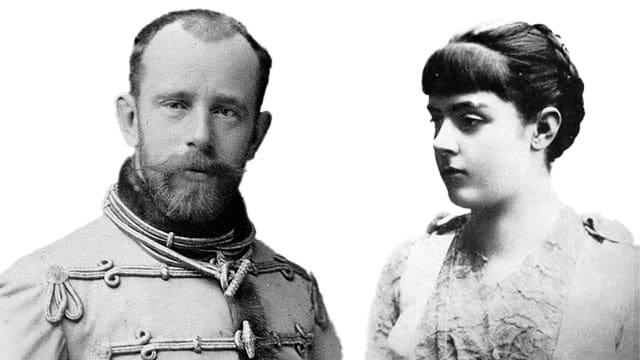Rudolf, heir to the Austro-Hungarian Empire, and his lover, Mary Vetsera, were found dead at his hunting lodge in Mayerling in 1889
 It was the 1968 movie of the same name that first brought Mayerling to my attention. Opulently photographed in Viennese locations, it was a glossy attempt at telling the story of Crown Prince Rudolf, heir to the Austro-Hungarian Empire, and his teenage lover, Baroness Mary Vetsera.
It was the 1968 movie of the same name that first brought Mayerling to my attention. Opulently photographed in Viennese locations, it was a glossy attempt at telling the story of Crown Prince Rudolf, heir to the Austro-Hungarian Empire, and his teenage lover, Baroness Mary Vetsera.
Omar Sharif played Rudolf and the perpetually stunning Catherine Deneuve took the role of Mary. Neither of the real historical figures bore much physical resemblance to those portraying them.
Rudolf was born in 1858, the only son – and thus heir apparent – of Emperor Franz Joseph. With both parents being mostly absent, his childhood was lonely, an experience that’s often regarded as a contributor to his later emotional fragility.
He was, though, curious about the outside world, a (sometimes incognito) international traveller, and a relative liberal in his approach to politics. It wasn’t a question of wanting to dismantle the Empire, but rather to make it more sympathetic to the sensitivities of its constituent parts and less identified with the aristocracy.
 Rudolf, Crown Prince of Austria and Baroness Mary Vetsera. |
| More from Pat Murphy |
| Who was to blame for the First World War?
|
| Does Trudeau view Canadians as his fellow citizens or merely his subjects?
|
| Who Is Pierre Poilievre really?
|
In an 1886 exchange with French politician (and subsequent prime minister) Georges Clemenceau, Rudolf pitched the concept of the multi-national Austro-Hungarian Empire as a precursor of a “United States of Europe.” The Empire was, he said, “a block of states consisting of the most diverse nations and races under one rulership.” And even if the current execution was “not completely harmonious, this does not mean that the idea itself is wrong.”
However, getting any traction for his reforming aspirations was very difficult. Franz Joseph, Rudolf’s father, was on the throne and their visions weren’t in sync.
Rudolf’s personal life was also a mess. He was both a heavy drinker and notoriously promiscuous – so much so that he contracted venereal disease and passed it on to his wife. Author Angus Robertson describes Rudolf’s late 1880s situation this way: “For more than three years he had been prescribed a dangerous cocktail of opium, morphine and cocaine, which he consumed in addition to copious amounts of cognac and champagne.”
Rudolf’s last lover was the besotted teenager Mary Vetsera. On January 29, 1889, he spirited her off to his hunting lodge at Mayerling. They were found dead the following morning, dispatched by gunshot wounds to the head in an apparent suicide pact. Mary died first, after which Rudolf turned the revolver on himself.
Unsurprisingly, the first instinct was to cover it up. With Mary’s body spirited away and obscurely buried, Rudolf was said to have been felled by a heart attack. That story quickly fell apart thanks to a ravenous international press.
Then there was the problem of Rudolf’s burial. Strictly speaking, the circumstances of his death precluded burial on consecrated ground. So a fudge was called for.
Rudolf’s death was ascribed to “mental imbalance” – a formulation with which the Vatican went along – and his coffin was escorted with full military honours for interment in the magnificent imperial crypt at Vienna’s Capuchin monastery. It still resides there today.
Not everyone was entirely comfortable with this arrangement. To quote the Vatican’s man in Vienna: “This will probably be the first time that a Papal Nuncio will attend the funeral of a murderer and a suicide representing the Pope.”
Because history buffs love “what ifs,” it is natural grist for the mill to question what might have happened had Rudolf lived.
Could he have sufficiently pacified ethnic grievances to save the Empire? More important, might the catastrophic First World War have been averted?
Of course, posing these questions presupposes Rudolf being a much more stable personality than he actually was. But putting that aside, the proposition is a dubious one.
Granted, had Rudolf lived, there’s no particular reason to believe he’d have been in Sarajevo on that fateful June 1914 day when Franz Ferdinand – his successor as heir presumptive– was murdered by a Serbian nationalist. And absent the assassination of the heir, one of the war’s precipitators would’ve been removed.
But Rudolf’s long-lived father – Franz Joseph – was still in power in 1914 and thus calling the shots. Rudolf’s reforming vision wouldn’t have been the one that mattered.
And even if Rudolf had been in charge, he’d have been swimming against the powerful spirit of the times.
Although the Empire’s population of 50 million made it Europe’s third most populous state, its multi-national character – 15 languages – rendered it very fragile. It was doomed by its exceptional diversity in an era of rampant ethnic/racial nationalism.
No, Mayerling wasn’t a world-changing event. It was just a sordid scandal.
Troy Media columnist Pat Murphy casts a history buff’s eye at the goings-on in our world. Never cynical – well, perhaps a little bit.
For interview requests, click here.
The opinions expressed by our columnists and contributors are theirs alone and do not inherently or expressly reflect the views of our publication.
© Troy Media
Troy Media is an editorial content provider to media outlets and its own hosted community news outlets across Canada.

